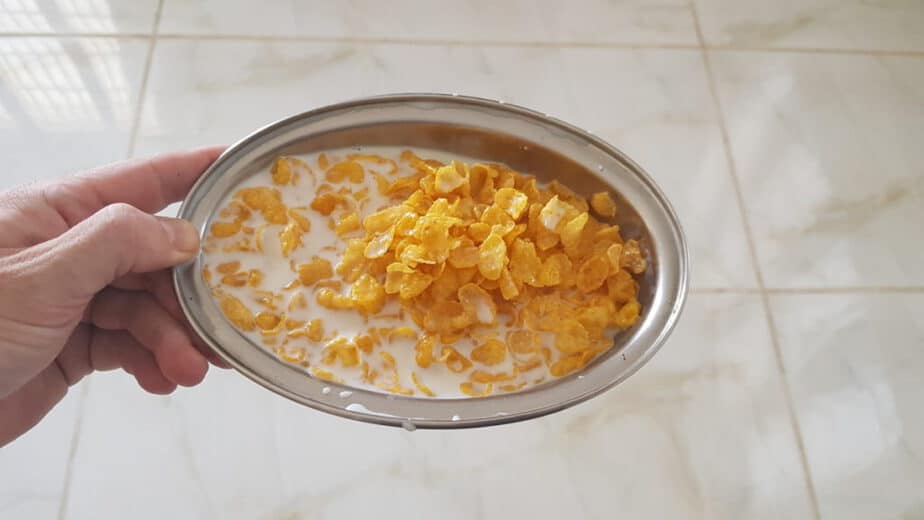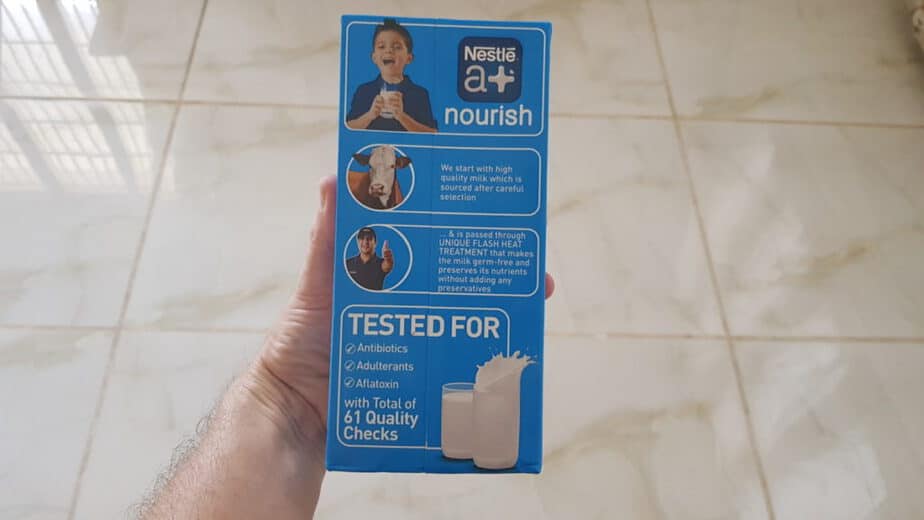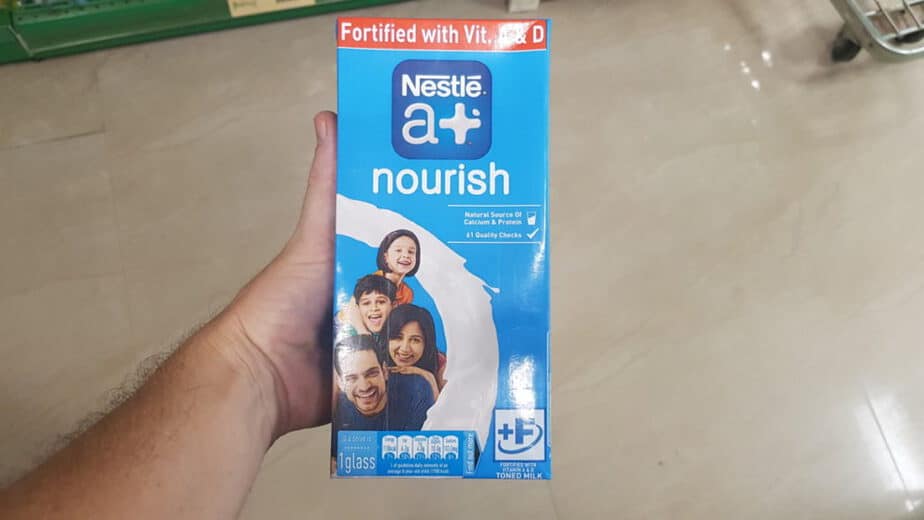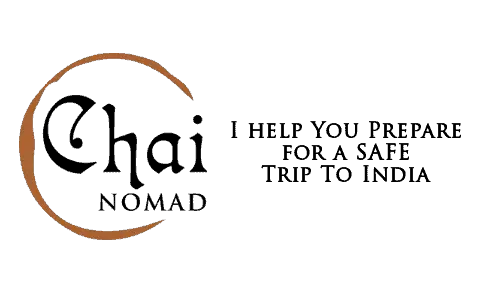I’ve been traveling in India for almost a year now, and I’m still a little scared to drink milk. I do have milk in my masala chai almost every day. I also like a nice bowl of cornflakes in the morning sometimes too, and so far I haven’t gotten a deadly illness… yet. But I still wonder…
Is milk safe to drink in India? Milk in the store from brands like Amul or Nestle is pasteurized, so it is safe. If you buy raw milk, boil it for 30 minutes at 63 °C (145 °F). Avoid milk in restaurants, unless it’s been boiled such as in chai. Cold milk in nice hotels and restaurants is okay though.
There are more risks associated with drinking milk in India than in countries like the US or Canada or the UK, where there is a heavily regulated industry. Plus many people drink raw milk from local cows.
I see men almost every day riding a bike with a big metal jug on the back, selling milk that they just got from the cow nearby. Sounds fresh and creamy, right? It is! Many local restaurants will use it too.
But it may not be safe, and if you want to enjoy a nice cold glass of milk or some corn flakes, you probably want to understand the risks, the consequences if things go wrong, and how to get the safest milk.
I’ve been here almost a year now and done hours of research to answer this question for myself. Here’s what I’ve learned…
Is Milk Safe to Drink in India?

India is a big producer and exporter of milk. With their respect and reverence for cows, you would think the milk would be AMAZING to drink here. There is also a lot of fresh milk available, which can be very healthy… It could have nutrients like:
- Calcium
- Healthy fats
- Iron
- Omega-3 fatty acids
- Vitamin A
- Magnesium
- Zinc
- Thiamine (B1)
- If it’s grass-fed it could have Vitamin E or beta-carotene
However, as much as two-thirds of milk in India, may not pass food regulations.
As a traveler who’s new to India, our stomachs are especially sensitive. Drinking milk safely depends on where you get the milk, how it’s processed and how it is handled, let’s dive into how to drink milk safely.
Buying Pasteurized Milk
If you buy milk from popular brands, such as Amul and Nestle, you’re going to get pasteurized milk. It’s the same as you’d get in a country like the US or in Europe and you can drink it straight from the carton.
If you were to pasteurize your milk at home, you would heat your milk up to 63°C (145°F). You’d then keep it boiling for about 30 minutes. Then you can let it cool and store.
Most Indians are so used to boiling their milk, it even states on the package… you do NOT need to boil this milk, haha.
However, there is an additional risk here that I will cover below.
Buying Raw Milk
Local milk men drive by on bikes calling or ringing a bell, then you will see women come up with their own jug to get fresh milk.
I see men milking their cows in the street or in their field, and it looks very white and creamy.
I have NEVER drank this milk though and I would not drink it. I could pasteurize it myself but I may make a mistake, haha.
Even if I did pasteurize the milk correctly and killed off the bad bacteria, then there is also a risk the cow is not healthy.
I might try it once I’ve been in India for a number of years and get to know some farmers and healthy cows… But at this point, I’ll stick to milk out of the jug in the grocery store.
Drinking Milk in Coffee and Chai
You never going to get a 100% safety-approved stamp in India, so it is on you a bit to judge.
I drink chai and coffee from everywhere though, and haven’t had any problems after a year.
At chai shops, they will keep the milk close to a boil the whole day. They will have a burner with three pots:
- In one pot, you have almost boiling water. They will clean your cup with this before they pour you a chai. You will want to make sure they do this 🙂
- In another pot, you will have chai. It’s probably been cooking all day. My friends used to say they never liked the chai in the early morning because it hasn’t had time to properly cook and is weak.
- In the third pot, is the milk. It’s probably been cooking so long that there is very little chance of getting sick.
In South India, “filter coffee” is popular. It’s basically a strong shot of coffee mixed with a lot of milk. At small stands, they just use instant coffee, but at better stands or restaurants they might roast and grind the beans themselves.
The process for making the coffee is similar to chai. They boil the milk as they heat the coffee so that they are serving it and killed anything that may have contaminated it.
Drinking Cold Milk from Hotels and Restaurants
There’s a nice breakfast buffet in the town that I am spending a lot of time in here, and they have corn flakes. I put cold milk on it, a bit of sugar, and munch away without ever having gotten sick.
This restaurant is one of the nice restaurants in town that is commonly known to have safe food. They also have a hotel that caters to tourists both Indian and foreign.
If you’re traveling from city to city, you can find places that will be pretty safe for drinking milk.
If it’s a popular hotel on an app like Booking.com, and there are a lot of reviews from foreign tourists saying the food is good and healthy… then you’re probably okay.
These hotels and restaurants make their living from tourist dollars so if they get a few tourists sick and get bad reviews, it could tank their business. Therefore they have a strong incentive to keep things sanitary and clean, and you can have a good chance to enjoy some cornflakes if you want 🤓
Additional Risks with Pasteurized Milk in India

I mentioned covering an additional risk with pasteurized milk and that’s: the adulteration of milk.
Sounds scandalous, right? And it is. A good percentage of milk in India is contaminated and would not pass high quality standards.
Why would someone contaminate milk? It increases the quantity of milk, and therefore makes them more money.
Picture if you were a dairy farmer in India and there was intense pressure to make a living. Or a dairy company. There might be an incentive to get more money.
So even pasteurized milk could have chemical substances in it. Common adulterants are:
- Soap
- Acid
- Starch
- Sugar
- Formalin
- Urea
- Detergents
If the milk in the grocery store isn’t 100% safe, what can you do to make sure your milk is healthy?
You can buy an adulteration test kit on Amazon (click here to see the current price).
I tried it. I wanted to see if I could detect any contaminated milk in a small test, so I bought the tests and two different brands of milk.
In my experience, both the brands were safe milk that was uncontaminated.
However, I realize I’d need a larger sample size to get a more accurate test. AND I’d need to go to many different grocery stores around India since quality would vary.
Wrap Up:

We can’t be 100% certain that the milk we drink in India is safe, but if you do these things you can significantly lower your risk:
- Buy established pasteurized milk in grocery stores like Amul or Nestle
- Drink milk that’s been boiled and is still hot in your chai or coffee
- Drink cold milk at hotels and restaurants with great reviews on Booking.com
- Randomly test your milk with adulteration tests on Amazon
- Or avoid milk and drink it when you get home 🙂
Related Questions:
Is it Safe to Drink Pasteurized Milk Without Boiling?
If the milk is pasteurized, then it is safe to drink without boiling. It is a cultural custom in India to boil their milk. They are so used to having raw milk straight from the cow. Many will boil it over and over, right before they drink it. However it is not necessary with pasteurized milk from known brands like Amul and Nestle.
Can We Drink Amul Gold Milk Without Boiling?
You can drink Amul Gold without boiling it, because it is pasteurized.
Can We Drink Amul Milk Without Boiling?
Amul milk that you buy in a store is pasteurized and you do NOT need to boil it before drinking it.
Is It Safe to Eat Yogurt in India?
Yogurt is safe to eat because it has been fermented and cooked. It is more safe than many types of milk for this reason. As long as it has been properly covered and is eaten within a reasonable time frame, it is a safe way to consume dairy in India.
Is Bread Safe to Eat in India?
Bread is cooked and safe food for tourists to eat in India. Flatbreads like dosa and parotta are some of the safest foods to eat actually because they must be recently cooked before being served. Ragi bread or loafed bread is also safe.
Is It Safe to Eat Bananas in India?
Bananas are one of the safest foods to buy and eat from a roadside stand because they have a thick peel. To be safe, peel the banana with one hand so that you can eat the banana with a clean hand. This will prevent any contaminants that were on the peel touching the fruit.
For more details about eating bananas safely and other tips for eating healthy in India, check out my post.
I also made a video about peeling a banana with one hand, and what street foods to avoid.

